shinjuku

Shinjuku
Shinjuku is a strategic network-building and pick-up-and-deliver board game.
In Shinjuku, you build department stores in Tokyo and the rail lines to connect them so that you can build the most successful shopping/rail conglomerate.
Rule Summary
Every turn, new customers will arrive on the map looking to purchase one of 4 different goods. On your turn, you choose 2 different actions from: (a) Open a store, (b) Expand your rail, (c) Upgrade to a department store, (d) draw cards as Income or (e) Move customers along the rail to stores.
You start with a hand of 4 location cards and get a new card each turn. The Build, Upgrade and Move actions require that you play a matching location card from your hand. Cards in your hand that match locations where you have previously built a store are Wild and can be used to match any location.
The game ends when the last customer is placed (+ one final turn for the other players) and victory goes to the player that can create the most sets of each type of customer.
Links
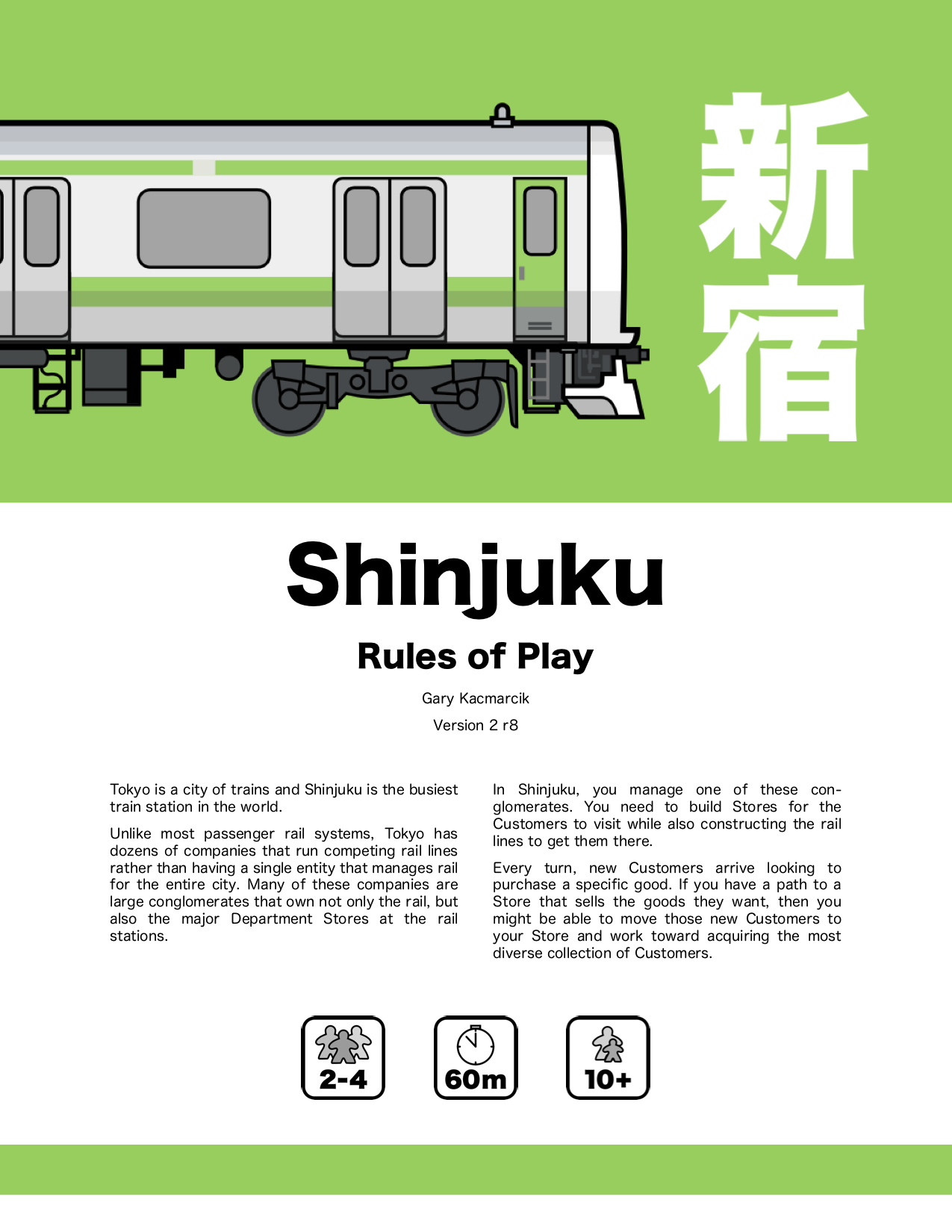 |
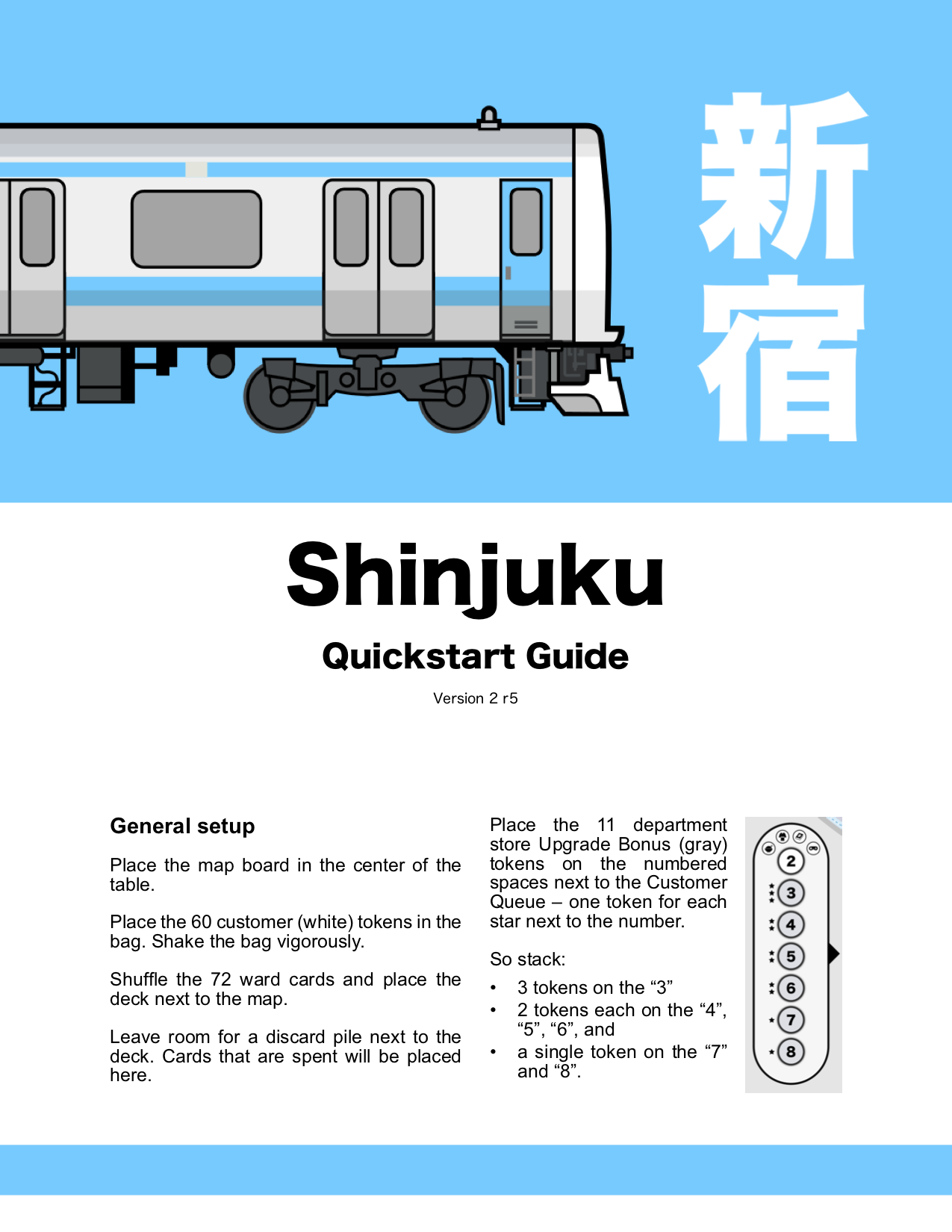 |
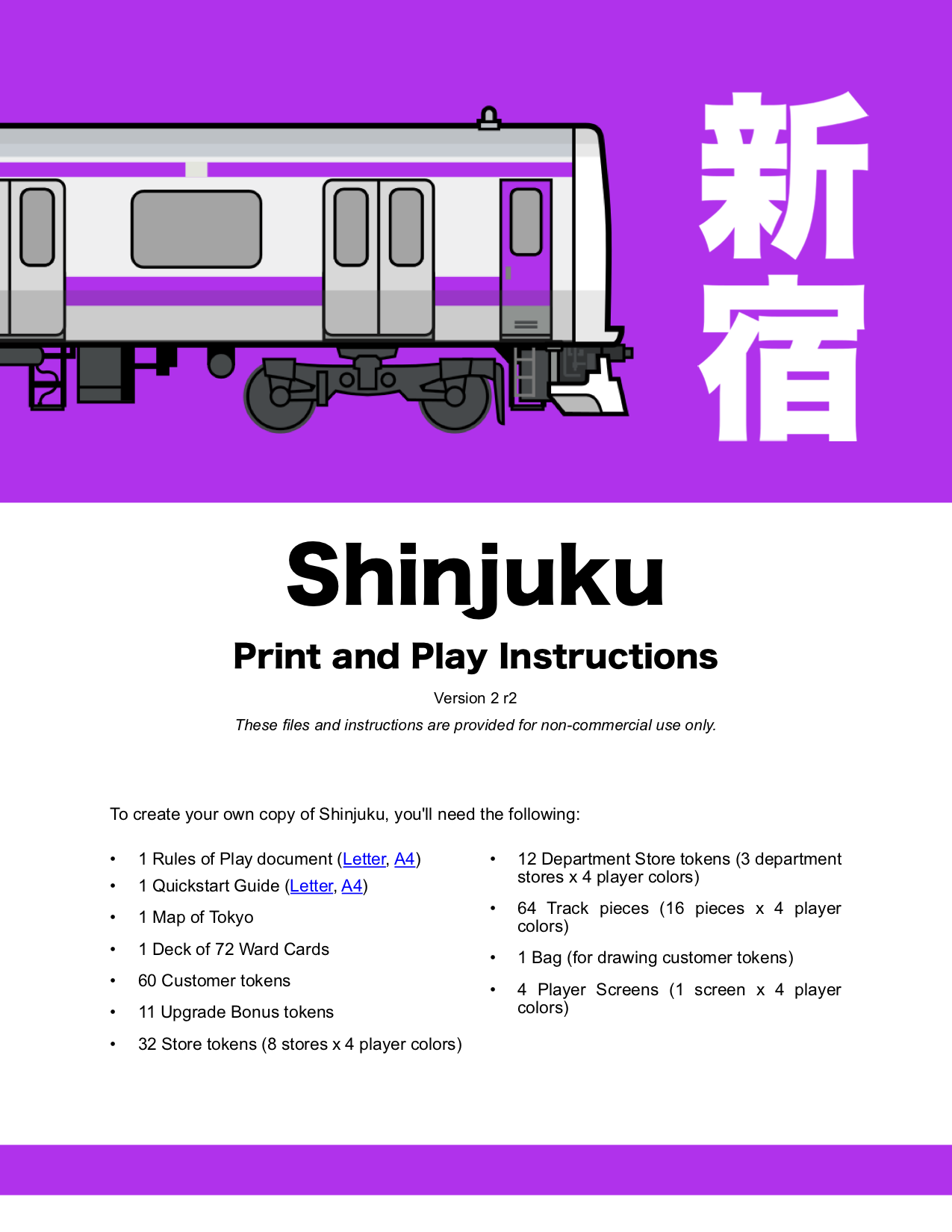 |
| Rules of Play Letter, A4 |
Quickstart Guide Letter, A4 |
Print and Play Letter, A4 |
- Online virtual tabletops:
- Videos
- General Overview (4:42 rule/gameplay summary)
- Print and Play Instructions
Game Development Links
- Game categories: strategic; network building; pick-up and deliver, set collection
- Design Notes/Diary - BGG or here on github
- Github repository
- Playtest notes
- Blank playtest comment sheet (pdf)
Background
Tokyo is a city of trains and Shinjuku is the busiest train station in the world.
Unlike most passenger rail systems, Tokyo has dozens of companies running competing rail lines rather than having a single entity that manages rail for the entire city. Many of these companies are large conglomerates that own not only the rail, but also the major department stores at the rail stations.
In Shinjuku, you manage a rail conglomerate in Tokyo. You need to build stores for the customers to visit and also the rail lines to get them there.
Every turn, new customers will arrive looking to purchase one of 4 different goods. If you have a store that sells those goods, then you might be able to move them to your store and earn them as a customer (=VP).
- 2-4 players
- 60 minutes
- Ages 10+
How to Play
Map Board
Shinjuku is played on a map of central Tokyo:
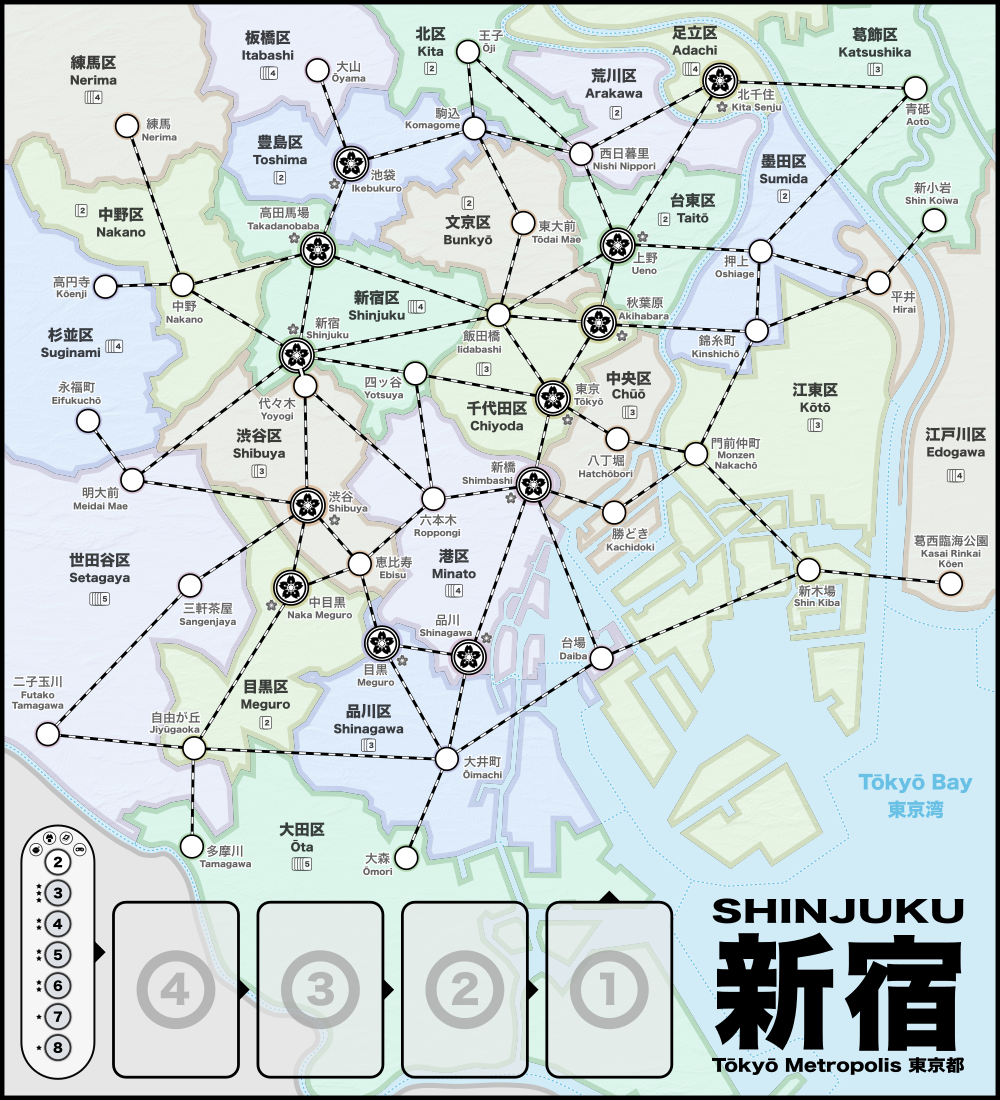
The map is divided into the 23 regions (known as “wards”, or “区” (ku) in Japanese).
Each region contains 1 or more train stations and these stations have lines that identify potential connections to other stations. Some stations have a sakura icon to indicate that stores built there are allowed to be upgraded to a department store.
On the bottom of the board is the customer queue (④ ③ ② ①). Customers will accumulate here before moving on to the map.
Cards
There are 72 cards and each card identifies a single ward on the map.


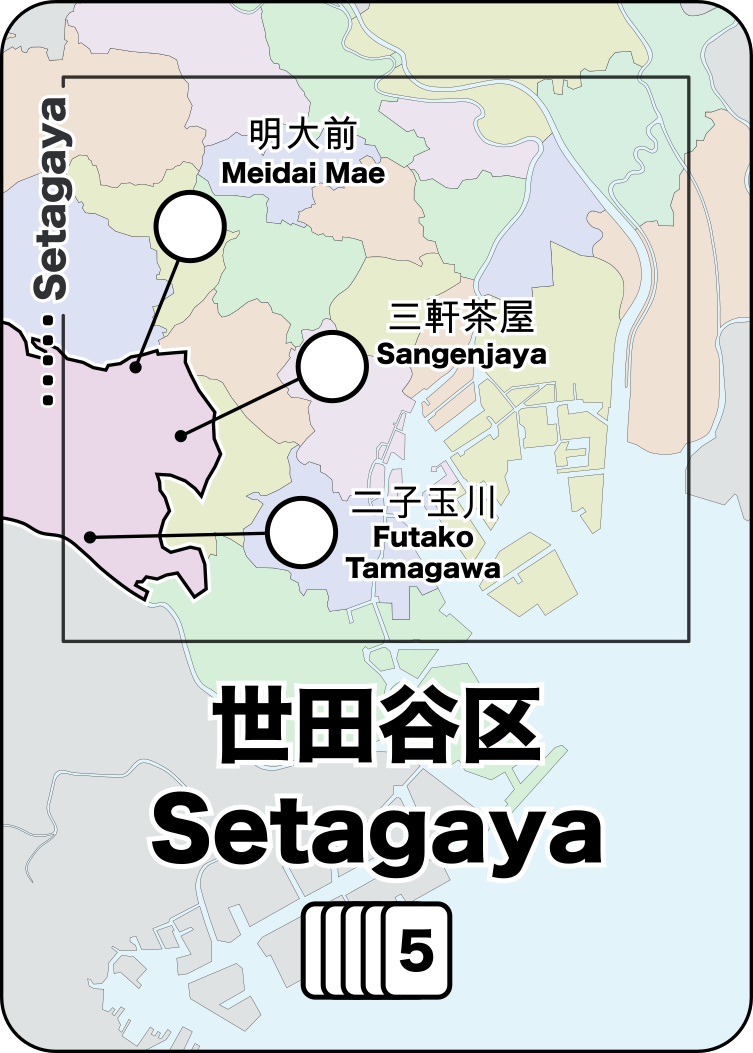
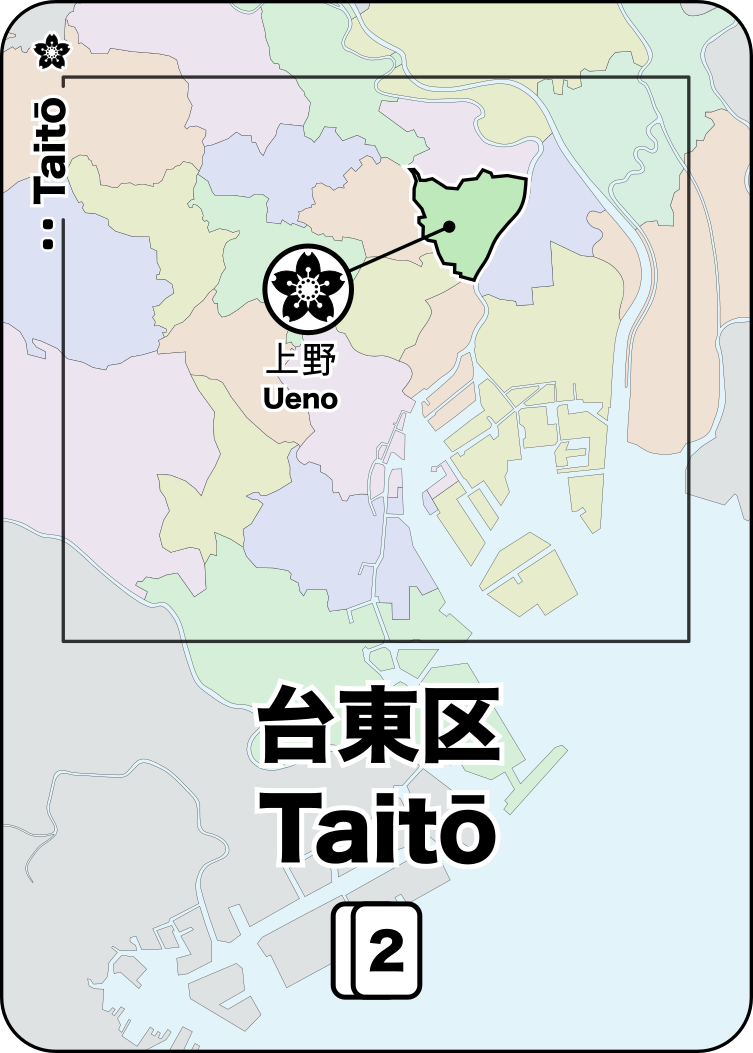
There are multiple copies of each card based on the population of that ward. The numbers on the map and on each card indicate how many of each card are in the deck (this information is important later).
Player Pieces
Each player starts with 3 department stores, 8 stores and 16 track segments.

There are 4 kinds of stores:
 |
sells Food |
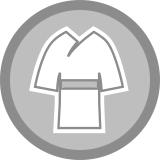 |
sells Clothing |
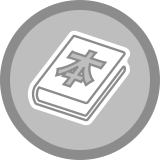 |
sells Books |
 |
sells Electronics |
A department store (represented by a tall cylinder) sells all of these goods.
Customers
There are a total of 72 customers. They are stored in a bag so that they can be drawn at random.
The 4 customer types match the store types:
 |
23 customers want Food |  |
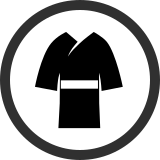 |
20 customers want Clothing |  |
 |
16 customers want Books |  |
 |
13 customers want Electronics |  |
Some customer tokens are marked with a “2” which indicates that they count as 2 customers during scoring:
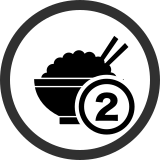
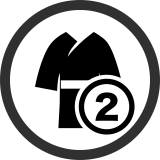
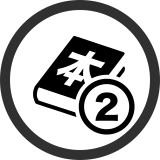
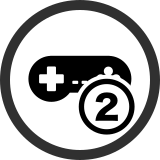
Upgrade Bonus Tokens

Players can earn a stack of Upgrade Bonus tokens when they upgrade one of their stores to a department store.
These tokens can act as a customer of any type during the endgame set-collection scoring.
Matsuri (Festival) Token

The Matsuri token is moved each turn and identifies where a festival is taking place. Cards that match the festival location are wild.
Gameplay
Per-player Setup
-
Choose a player color and take the matching pieces
-
Draw 4 cards into your hand.
General Setup
- Add initial customers to map:
- Draw 4 different ward cards (re-draw if you get a duplicate)
- Draw 2 customers for each location drawn
- Determine starting location for the Matsuri:
- Draw a ward card
- Place the Matsuri token in that location
-
Choose a starting player and have them take the Start Player Token.
- Initialize the Customer Queue:
- Draw 4 ward cards and place them on the 4 queue spaces: ④ ③ ② ①
- Add 2 customers to the queue.
To add a customer to the queue:
- Draw a customer from the bag
- Is there already a customer of the same type in the queue?
- If so, place the new customer on the card with the matching customer
- Otherwise, place the new customer on the next available (empty) card.
Each Turn
Move the Matsuri
Move the Matsuri token from its current location into a neighboring location.
Place Customers
Customers are taken from the queue and placed on the map as follows:
- Take all the customers from the head ① of the queue and then place them in the location indicated by the card they were sitting on.
- Note that the customers are placed in the ward, not in any particular station. Customers are not associated with a station until they are being Moved.
- Take the card from the queue (where the customers were taken) into your hand.
- Refresh the customer queue.
To refresh the customer queue:
- Slide the existing cards (with customers) down
- Draw a new card and place it on ④
- Add customers to the queue equal to the number that were just placed on the map.
Take Two Actions
Choose any two of the following actions (must be different actions):
- Open Store : Spend a ward card and open a store at any empty station in that ward.
- Expand Track : Build a single piece of track on any empty connection on the map. Optionally, you may spend a card that matches either end of the newly placed track to build a second segment of track that is connected to the first.
- Upgrade Store : Spend a matching ward card and a matching customer to upgrade an existing store to a department store. The spent customer is added to the customer queue and the old store is returned to you. You may now claim the next department store Upgrade Bonus Token (if any remain). Note that stores can only be upgraded if they were built in a station marked with the department store icon.
- Draw Income : Draw your hand back up to 4 cards, or draw a single card if you already have 4 or more cards in hand. Your turn ends immediately after taking this action, even if you had one more action available.
- Move Customers : Spend a ward card to move the customers in that ward to stores, following train tracks to connected stations.
Wildcards
You can play a wildcard to match any card. There are no explicit “wildcard” cards in Shinjuku, but you can create wildcards during gameplay:
…from cards
You can play any three cards from your hand as a single wildcard.
…from stores
Once you’ve built a store (or department store) in a ward, the cards for that ward become wildcards for you.
Because the card frequency varies based on the population of that ward, some wards work better as wildcards (because you’re more likely to draw them).
…from the Matsuri
Cards that match the current location of the Matsuri token are wild.
Moving Customers
The Move action is the most important action in Shinjuku because it is the only way to gain customers (which are needed to win the game).
When you choose the Move action, do the following:
- Gather all of the customers in the ward that matches the card played
- Select their starting station within that ward
- Move the customers from station to station on the map, following the track connections that players have added.
- If the station has a store that matches a customer, then the store satisfies the matching customer and it must be given to the player that owns the store.
- A store can satisfy a single customer that matches the store type. A department store can satisfy a single customer of any type.
- If more than one customer matches (e.g., with a department store; or if there are multiple customers of the same type), then you may choose which single customer is given to the store owner.
- No station may be visited more than once during this action.
- If the station has a store that matches a customer, then the store satisfies the matching customer and it must be given to the player that owns the store.
- Any remaining customers are added to the ward that contains the final station visited, merging with any existing customers in that ward.
- If any track segments owned by other players were used during the Move action, then those players may immediately take an Income action. Maximum one Income action per player, regardless of the number of track segments used. You (the player taking the Move action) are not entitled to this Income bonus.
End of Game
When the last customer is drawn from the bag, play continues until the customer queue is emptied. The player that places the final customer from the queue finishes their turn and play continues until the player with the Start Player Token (so that every player has the same number of turns).
Endgame Scoring
Customers are scored using set collection plus any bonuses from department store upgrades.
- 10 pts for each set of 4 different customers
- 6 pts for each set of 3 different customers
- 3 pts for each set of 2 different customers
- 1 pt for each remaining customer
Customers marked with a “2” count as 2 separate customers.
In endgame scoring, each Upgrade Bonus Token acts as a wild customer and can be used in place of any single customer.
